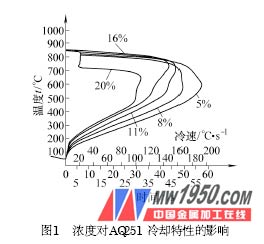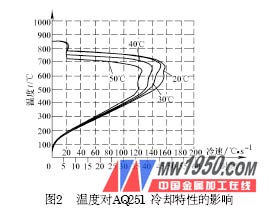The heat treatment process is mainly composed of heating and cooling. Once the state of the product is determined, the cooling medium will play a decisive role in the cooling process. The traditional quenching medium is mainly water and oil. With the continuous improvement of the mechanical properties of mechanical products, the cooling characteristics of the traditional quenching medium can no longer meet the needs of heat treatment. The cooling rate of water in the high and low temperature stage is relatively fast, and it is easy to produce quenching cracks, while the cooling rate of oil in the high and low temperature stage is slow, so that the performance cannot meet the technical requirements of the product. The development of an ideal quenching medium, that is, a medium with a high cooling rate in a high temperature stage and a slow cooling rate in a low temperature stage, has been widely studied as a new subject. In the mid-1990s, the new quenching medium represented by AQ251 introduced by Houghton Company of the United States was gradually promoted and applied. It not only has good cooling characteristics, but also has the characteristics of safety, reliability and no fire hazard compared with oil. Therefore, it is welcomed by many companies. At the beginning of the application, AQ251 reflected very good results, but over time, the shortcomings of this water-soluble quenching medium began to be exposed, that is, its aging problem. Quality problems caused by aging of water-soluble quenching media have frequently occurred, causing many irreparable losses. The loss of material blank caused by aging of quenching medium in a locomotive factory in 2005 was more than 500,000 yuan, and a large number of surface quenching cracks appeared in medium frequency quenching. Therefore, it is an urgent task to study the changes in the maintenance and cooling characteristics of water-soluble quenching media to find control methods. First, the cooling characteristics of the quenching medium The evaluation of the cooling capacity of the quenching medium is generally compared with the results of the cooling characteristic detection, and the cooling characteristics are composed of a cooling characteristic curve and characteristic data. The cooling characteristic curve includes a cooling process curve and a cooling rate curve. The characteristic data consists of the maximum cooling rate (v max), the temperature at which the maximum cooling rate occurs (Tvmax), and the cooling rate at 300 °C (v300). The detection of the cooling characteristics of the quenching medium is generally carried out under the same conditions using a cooling characteristic tester, that is, the quenching temperature, the medium temperature, and the detection time are the same, and the cooling rate curve can be simply drawn by using the characteristic data. Second, cooling characteristics control Controlling the cooling characteristics of the water-soluble quenching medium is to find out the change law of the cooling characteristics through experiment and use, and then formulate the control target and put it into practice according to the material and structural characteristics of the product. Due to the reverse solubility of water-soluble quenching medium, the consumption at the production site is also large, which needs to be adjusted and supplemented frequently. It cannot be replaced frequently due to economic considerations. Therefore, it is economical and scientific to detect and control the cooling characteristics. . 1. Effect of concentration on cooling characteristics We used the KHR-01 Cooling Characteristic Tester produced by Zhengzhou Kehui High-Tech Development Co., Ltd. to test the newly prepared 5% to 20% series AQ251 solution. The results are shown in Figure 1. It can be seen from Fig. 1 that the v max of AQ251 decreases with the increase of concentration, and Tvmax tends to increase first and then decrease with the increase of concentration. When the concentration falls below 8%, Tvmax decreases to about 600 °C, and the concentration is 5%. At the same time, the v300 is increased to 87 °C / s, which is close to the cooling characteristics of the clean water, and the low-temperature cooling ability of the quenching medium is sharply increased. After the concentration exceeds 20%, Tvmax decreases, but its vmax and v300 are still low, so its cooling capacity is still low. It can be seen from the above that the optimum concentration range of AQ251 is 10%-20%. After less than 10%, v max and v300 increase sharply, and the PAG quenching medium has an aging tendency to decrease Tv max. In this way, the product has a higher cooling rate in the low temperature zone and an increased tendency to quench cracking, so try not to use it. 2. Effect of temperature on cooling characteristics Using the same testing equipment, we tested the 20% to 50 °C series cooling characteristics of the 13% crankshaft quenched and tempered AQ251 used in the field. The test results are shown in Figure 2. Next page Multi Jet Water Meter,Jet Water Meter,Multijet Meter,Master Meter Multijet Shandong Chenshuo Meter Co., Ltd. , https://www.chenshuometer.com

It can be seen from Fig. 2 that as the temperature increases, the v max of the medium increases, and Tvmax and v300 remain substantially unchanged. However, it can be seen from the curve that although the changes of Tvmax and v300 are small, there is no significant change in cooling in the high temperature stage, but the cooling capacity in the low temperature stage is still increased, so the influence of temperature on its cooling characteristics cannot be ignored. For quenching and tempering parts, especially those products with obvious quenching tendency, the temperature range of quenching medium should be appropriately limited. For induction hardened workpieces, since hardenability is not the main factor affecting quality, consider increasing the concentration of AQ251 and lowering the low temperature stage. The speed of the cold, without limiting its temperature.